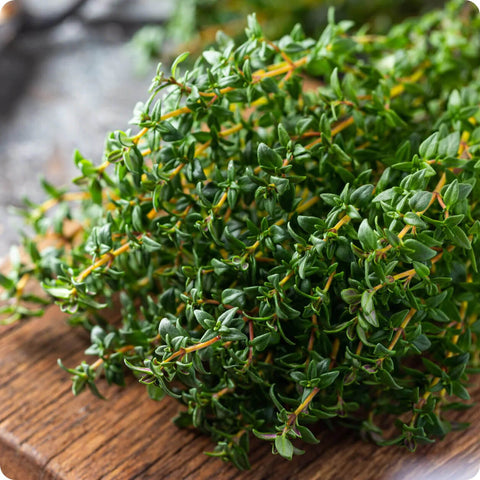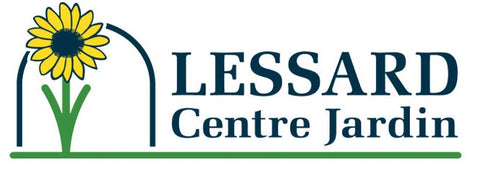

Hortinova
THYME - Open Pollinated Winter Thyme Seeds
Thymus vulgaris
- Fast growing plant with small, very aromatic leaves and a slightly bitter, peppery taste.
- The semi-woody stems and the flowers can be consumed.
- Can reach 30 cm in height and tolerates the drought.
- Like oregano, it keeps very well dried.
Sow thyme seeds indoors about 6-8 weeks before the last expected frost date. Thyme seeds are tiny, so sprinkle them lightly on top of well-draining seed-starting mix and lightly press them down. Keep the soil moist but not waterlogged. Once the seedlings have developed a few sets of true leaves, they can be transplanted outdoors or into individual pots.
Choose a sunny location for your thyme plants as they thrive in full sunlight. The soil should be well-draining. Thyme will tolerant a wide pH range on either side of neutral (pH 7.0). It does fine in soil from pH 6.0 to 8.0. It is relatively tolerant of poor soil, making it a great choice for rocky or less fertile areas.
TRANSPLANT: Transplant the seedlings outdoors after the last frost date when the soil has warmed up. Space the plants about 12 to 18 inches apart, allowing enough room for them to spread as they grow.
WATER: Thyme prefers dry to medium moisture levels, so be cautious not to overwater. Once established, water the plants only when the soil feels dry to the touch. Overwatering can lead to root rot and other issues.
FEED: Thyme is a light feeder, and excessive fertilization can lead to reduced flavor in the leaves. A balanced, all-purpose fertilizer can be applied sparingly in the spring or early summer. Alternatively, you can use compost or organic matter to provide necessary nutrients.
PROTECT: Apply a layer of organic mulch around the base of the thyme plants to help retain moisture, suppress weeds, and regulate soil temperature. Thyme is relatively resistant to pests and diseases, especially when grown in well-draining soil with good air circulation. However, keep an eye out for aphids, spider mites, and fungal issues. If necessary, treat with organic insecticidal soap or neem oil.
PRUNE: Regular pruning is beneficial for thyme plants. Pinch off the tips regularly to encourage bushier growth and prevent legginess. Harvesting thyme leaves frequently also promotes new growth.
You can start harvesting thyme leaves once the plant has grown to a sufficient size. The best time to harvest is in the morning when the aromatic oils are at their peak. Use scissors or pruners to snip off the stems, leaving some leaves behind to continue the plant's growth.
Thyme can be dried for later use by hanging the stems upside down in a well-ventilated area. Alternatively, you can freeze thyme leaves or store them in oil or vinegar to preserve their flavor.
Let customers speak for us
from 23 reviewsWe grow several varieties of various colours of tomatoes, and the contrast of these tomatoes with other colours is fantastic. We've had a very long season with our plants, excellent disease resistance, great flavour.

This review applies to all of the seeds I purchased from Hortinova - beautiful tomatoes, good disease resistance and excellent production. Our field season extended to 10 weeks. We've had comments of excellent flavour from our customers as well, highly recommend any Hortinova seed.

This tomato is good taste tomato. Small red round tomato. Bigger then cherry tomatoes but smaller then regular one. I like it. Perfect for salads and fresh eating. Ordered seeds for next season.

2nd time ordering. Very satisfied with qualify and result. Thank you

BALCONY YELLOW F1 - Hybrid Cherry Tomato Seeds

Delivered very fast, packed very good, in professional condition and quality. Thanks

DUETT - Open Pollinated Radish Seeds

We will see what they are like this summer.

Type crimson de bonne grosseur avec une superbe uniformité et très hâtif. Un des premiers prêt en saison. Semences très petites et peu nombreuses. Goût très sucré et chaire croquante. Chair passant du rose au rouge en cours de saison. Les plants sont forts et très vigoureux avec des grosses feuilles.

Vigueur des plants impressionante avec des fruits résistants aux fissures et aux dommages. Très bonne conservartion et goût très sucré lorsque les nervures deviennent orange. Peu être récolté lorsque les nervures sont vertes également. Cavité des semences très compacte et petite laissant beaucoup de chair.

Melon qui fond en boûche avec un goût se rapprochant du melon miel et du cantaloup à la fois, très sucré. Faire attention aux irriguations lorsque le melon devient mature car il peut fendre au champs. Très odorant.

Avec son apparence côtellée, son très gros calibre et ça couleur rose, cette tomate se démarque des autres sur les tablettes. Variété plus résistante à la pourriture apicale que la plus part des autres tomates roses. Bon ensemble de résitance aux maladies également.

Tomate noire dont les faces qui ne sont pas exposé au soleil passent du vert au rouge lorsque mature donnant un aspect unique aux fruits. Charactéristiques similaires à la Barrio avec un goût superbe sans acide. Les clients l'on adoré.

Superbe adaptabilité et excellente résistance aux maladies. Fruits uniformes qui ne fendent pas, bonne conservation. Ajoutez à cela un goût unique avec une légère acidité et une pointe sucré.















